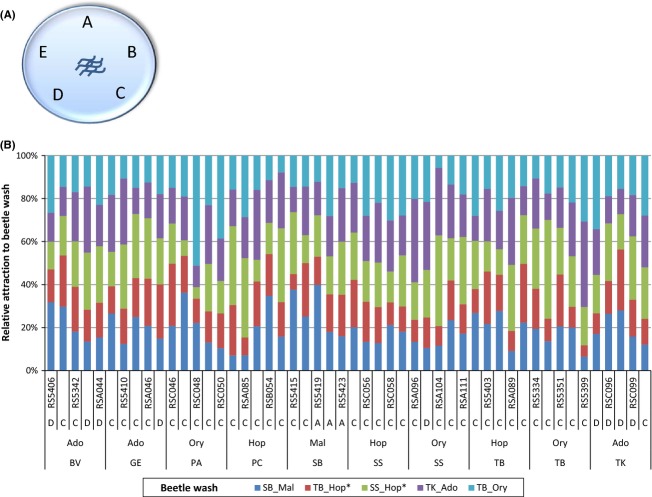Figure 5.
Results of multiple-choice assays: (A) Graphic to show the set-up of the assays, where five beetle wash attractants were spotted evenly around the assay plate at points A–E and nematodes were spotted in the center of the plate equidistant from these odor sources. The chemoattraction index (CI) was calculated as proportions among attractants relative to each other. A total of fifty assays using ten location/host beetle combinations (Table 1) were performed, with each assay replicated three times, to determine whether nematodes would show relative chemoattraction preferences to beetle washes; (B) Relative percentage of nematodes that chemotaxed to each point (A–E) on the assay plate for each assay for each beetle wash. Beetle wash is indicated by the key at the bottom of the figure (SB_Mal, Saint Benoit Maladera affinis beetle wash; TB_Hop, Trois Bassin Hoplia retusa beetle wash; SS_Hop, San Souci H. retusa beetle wash; TK_Ado, Takamaka Adoretus sp. beetle wash; TB_Ory, Trois Bassin Oryctes borbonicus beetle wash). Differences in attraction in response to the TB_Hop* and SS_Hop* washes were significant, as indicated by the “*” (Table 6). Nematode origin information (original beetle host association and geographic location) is given below the x-axis for each strain (Ado, Adoretus sp.; Ory, Oryctes borbonicus; Hop, Hoplia retusa; Mal, Maladera affinis; BV, Basse Vallée; GE, Grand Etang; PA, Palm des Palmiste; PC, Plan des Cafrès; SB, Saint Benoit; SS, San Souci; TB, Trois Bassin; TK, Takamaka). All strains are of genetic lineage, “A”, “C”, and “D” (Morgan et al. 2012), as indicated in Table 1.

